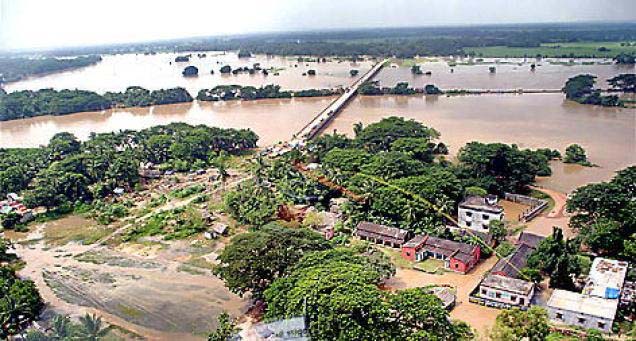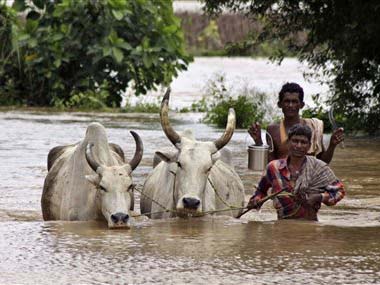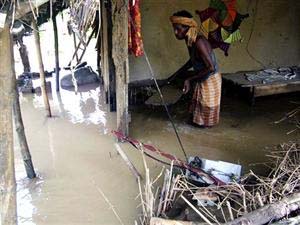Orissa was hit by two spates of flood in September 2011, the first one being caused by heavy rains in the Mahanadi catchment and release of huge discharges from Hirakud dam. The second one was caused by heavy rains and flooding of Brahmani, Baitarani and Budhabalanga rivers. These floods point to the loopholes in river basin planning and management and calls for urgent attention of planners and policy makers.

Image courtesy: The Hindu
The sheer scale of the flood can be judged from the fact that “nineteen of the state’s 30 districts are affected. Initial calculations by the state government reveal that almost 4.5 million people -- more than 11% of Orissa’s total population -- have been directly and significantly affected. Crops on 4.78 lakh hectares of land -- nearly 7.5% of total cultivable land have been destroyed. At least 68 deaths have been reported so far. More than 2,900 km of road have been damaged. Thousands of affected people are still desperate for food (Ranjan K Panda, InfoChange, October 5, 2011)”.
We present here some of the issues that have been raised on Orissa floods by Water Initiatives Orissa (WIO) through its press releases and updates in the recent weeks. The updates present analytical write-ups on the situation, latest news on impact of floods and relief rehabilitation measures. They also present an analysis of the water storage and rainfall situation on various dates most of which point to the lapses in dam management.
Hirakud dam failed miserably in managing Mahanadi floods
Flood Update II of WIO has a lead article titled “How effective are big dams in managing floods?” which presents important observations by scholars and experts on big dams. It states that the floods of 2011 exposes not only how the Hirakud dam, the largest reservoir in Orissa, a multipurpose dam commissioned in 1958 in Sambalpur for among other things controlling floods in the state's delta region has failed miserably in managing floods.
Both Orissa and Chhattisgarh must understand that Mahanadi needs to flow unabated and a lot has to be done regarding flood plain management including in urban habitations. Large dams have never been effective in flood control. Rather, they have always aggravated the impacts.
In a recent move the Governor of Orissa has asked the state government to investigate the alleged mismanagement of Hirakud dam through setting up of a Committee to be formed under the chairmanship of a former Central Water Commission (CWC) Chief.

Image courtesy: Firstpost
Rengali dam: Absence of reliable systems of flood forecasting
The Rengali dam, the second largest reservoir in Orissa was built across Brahmani river in Angul district in 1988. Through a special note WIO discusses how the multi-purpose project welters through controversies during each flood. Further, the incomplete canals have also added to the woes as water from the reservoir could not be drained out faster than envisaged.
At the crux of it, the dam authorities should never have allowed so much of water to stay in the reservoir preceding the recent floods till the last moment leading to devastation of about half a million people by design.
Effective flood mitigation through Rengali dam requires proper information well in advance about the flow conditions upstream as well as downstream of the dam. The Rengali dam releases travel in about 20 hours to the delta, which is only slightly less than the basin lag of the uncontrolled areas (about 24 and 30 hours for Brahmani downstream of Rengali and Baitarani respectively).

Image courtesy: Orissa Spider
Need for a flood management policy
The case of Rengali suggests that it’s time the state government comes up with a flood management policy which is not only technically advanced by integrating climate change scenarios but also transparent and involves all sections of the society through proper river basin management, reservoir operations and flood plain management activities.
Some specific suggestions put forth by WIO include –
- The first thing we need to understand is that we have to live with floods. All the mechanisms of better flood management practices, flood control measures, flood preparedness activities and flood forecasting practices depend on a reliable data transmission and telemetry system. Time has come that the government catch up with the scientific practices for better flood forecasting, flood control and flood mitigation measures.
- Regular and continuous study of river morphology, hydrology and necessary changes due to climate change and other phenomenon needs to be done so as to keep updating the flood management practices. The upper as well as lower catchments should have well defined stations for recording river discharge and water levels.
- Having interstate agreements for all interstate rivers for a proper mechanism of flood information sharing.
- Flood inundation area demarcation in the whole state.
- Flood plain zoning regulation be implemented.
Greater coordination with Chhatisgarh needed
The Government of Orissa put the responsibility of the flood on the heavy rain in the upper catchment and release of water from Chhatisgarh. However, daily and weekly predictions by the IMD were continuously warning of heavy spells. It proves that the dam management authority has not been following a coordinated approach with Chhatisgarh and IMD.
The Government of Orissa, which has been aggressively pushing for water sector reforms through Integrated Water Resources Management (IWRM) needs to also understand that Mahanadi belongs to Chhattisgarh as well and that the latter has to be taken on board.
WIO demands that “it’s time the Government of Orissa establishes proper communication and clearly defined coordinated action with Chhatisgarh on management and planning of Mahanadi river. It also demands that the Government of Orissa must, without any further delay, enter into a legally binding ‘water management and basin planning treaty’ that will help in management of Mahanadi water throughout the year.”
Disaster Management Authority caught unawares
In spite of being one of the first states to have a Disaster Management Agency in place, the state has virtually failed in both predicting and managing the floods.
Need for flood plain zoning
A press release from Water Initiatives Orissa (WIO) dated September 13, 2011 highlights the need for a participatory discussion on the National River Regulation Zone and a proper notification that helps in river basin planning and management.
It urges the Government of Orissa to immediately enact a legislation on the lines of the model bill on flood plain zoning that was circulated way back in 1975 by the Central Water Commission. The bill was meant to be taken up by state governments as a model for freeing flood plains from encroachments.
The model bill provided clauses about flood zoning authorities, surveys and delineation of flood plain area, notification of limits of flood plains, prohibition of the use of the flood plains, compensation and most importantly removing obstructions to ensure free flow of water. However, 36 years have passed and the state government has not brought it into action.
As an immediate measure, before this process takes place, WIO urges upon the government to issue strict circulars to all urban bodies of the state to remove encroachments from flood plains by entering into ‘free prior informed dialogue and consent’ process with the would be affected communities and by adhering to best rehabilitation packages.
The Government of India, under its Ministry of Environment and Forests (MoEF), had recently proposed to issue a river regulation zone notification to protect riverbeds from any harmful constructions in future. The press release urges upon the Government of Orissa to take proactive action to persuade the Government of India to put this plan in public domain and initiate discussion with each state and the people of the country and bring into force a strict river regulation zone which can help in proper river basin planning and management and hence help rivers from further dying and also in reducing flood furies.
Given that in this decade, the frequency of floods have increased and there have been five major floods, the state needs to draw lessons from its disaster filled history. It is high time that it looks for ecological measures for flood management and bans construction activities on the flood plains altogether. It is only with these holistic measures that least damage to life and property can be ensured in Orissa.
Download the updates and press releases by WIO below -
Water Initiatives Orissa (WIO) is a state level coalition of civil society organisations, farmers, academia, media and other concerned, which has been working on water, environment and climate change issues in the state for more than two decades now.
Contact details of WIO:
Ranjan Panda
Convenor, Water Initiatives Orissa
Sambalpur
Cell: 9437050103
Email: ranjanpanda@gmail.com, ranjanpanda@yahoo.com